How to Develop Custom Billing Software: The Ultimate Guide + Checklist
Updated: August 15, 2024
You’ve probably noticed how an increase in customer expectations plus the rise of real-time transactions and remote operations are making your billing process hectic. The reasons can vary: you may struggle with a mix of tools that don’t address all the challenges of your finance team or be stuck with outdated software solutions that prevent you from growing your business. Custom billing software development can solve all your billing woes.
With over 200 completed projects in eight years of remote development, at Relevant we know how custom software can boost billing operations, improve performance, and optimize costs.

We provide companies with senior tech talent and product development expertise to build world-class software. Let's talk about how we can help you.
Contact usIn this article, we’ll guide you through:
- The benefits of custom billing software over ready-made solutions
- The latest market trends in billing software development
- The core functionality and main requirements of billing software
- The stages of the development process and its estimated cost
So let’s get started!
Table of Contents
Building custom billing software vs using ready-made solutions
Businesses use billing software to generate and send invoices to their customers or partners, as well as to receive payments. By automating document preparation and other routine tasks, billing software helps companies improve performance and reduce errors.
If you’re about to adopt a billing software in your company, you have two options to choose from—buying a ready-made solution or developing a custom system. Let’s get the lowdown on each of them.
Ready-made solutions
If you need basic functionality or want to see how billing software works before developing a custom solution, a ready-made application may be a suitable choice. Here’s what you get when you buy one:
- Basic features. Ready-made software has the most essential features for billing automation, including invoice templates, reminders, and reporting tools.
- Third-party integrations. You can integrate applications with the most popular CRM and ERP systems, e-commerce platforms, or other third-party services.
- No training and setup. Ready-made solutions often have intuitive interfaces and 24/7 support to help your team start using them immediately. On the other hand, you need to choose the app wisely so that your finance team doesn’t drown in hundreds of unnecessary features.
However, you may encounter a problem once you need more unique features or a higher level of customization. A ready-made solution won’t make sense if you work with different customer groups who need to be treated differently depending on their payment models, languages, and compliance regulations.
Neither will it be helpful if you have a complex system of discounts, fees, or department limits to navigate, either. For the above-mentioned cases, custom billing software development is a more logical choice, so let’s talk about its benefits in more detail.
Custom software
A professional team of developers who will build an app end-to-end can help you tackle all the problems and challenges your finance department is currently facing. How? By tailoring software to your specific business needs. Here are the benefits you will unlock with custom software:
- Full system integration. No matter how complex your billing system is, custom software will help you integrate not only the market leaders but all existing services.
- Advanced functionality. Custom software allows you to set up non-linear workflows, custom analytics, and more to fully meet your requirements.
- High scalability. Modern software has a modular architecture. Whenever you need to adjust the workload or extend functionality, your development team will do it without downtime or performance failures.
When choosing the best option for your company, consider the complexity of your current billing system and your business goals. Opt for custom development if the applications currently available on the market can’t solve the challenges you face or if your business is growing fast.
To help you make a more informed decision, let’s take a closer look at the recent trends in the billing software market.
Latest trends in billing software
In 2018, the USA made e-invoicing mandatory for government agencies. In Europe, starting 2019-2020, all countries are obliged to use e-invoicing in public administration. Strong government support resulted in a market boom—the global e-invoicing market is expected to hit $24.726 million by 2027, five times more than in 2018. So what’s all the fuss about?
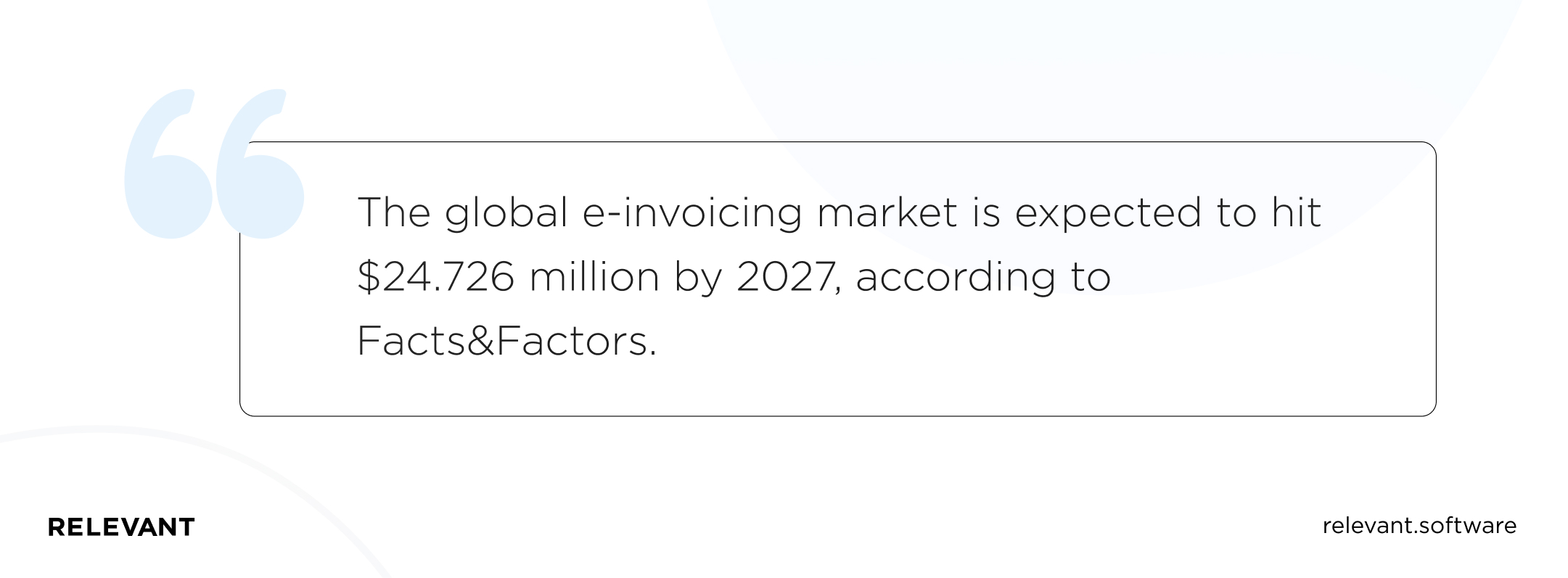
The growing demand for e-invoicing has been driven by business digitalization and the rise of real-time global payments due to the COVID-19 pandemic. Companies need money and don’t want to wait for days to complete a transaction. This has forced the e-invoicing and billing software market to adapt fast, resulting in constantly changing trends. Let’s walk through the major ones.
Automation
The level of automation in billing software continues to grow. Automation has become an essential aspect of all billing software, and the technology is getting more complex. Reminders and notifications, automated data entry, recurring billing, and payments on chosen dates are just a few examples of how automation may boost the billing process and allow your finance department to focus on high-value tasks instead of routine ones.
Machine learning and AI
Machine learning and AI technologies enhance automation with pattern recognition and predictive analysis tools. This allows companies to monitor financial transactions, reduce human interventions and errors, as well as identify potential fraud incidents.
Blockchain technology
Blockchain technologies are on the rise now. No wonder: the distribution of highly encrypted data across thousands of servers improves data security and eliminates the need for third-party data storage providers. Blockchain also makes transactions more transparent and allows companies to see any changes and interventions in real-time, reducing the risk of fraud and data breaches.
Cloud computing
How to create online billing software? By using cloud computing. Cloud storage eliminates the need for servers onsite and makes your data accessible from any device anywhere in the world. Thanks to remote access and real-time updates, cloud-based solutions allow companies to react to urgent issues more quickly. On top of that, cloud-based software enables multiplatform workflows, which brings us to the next point.
Mobile invoicing
Business operations are becoming more mobile-oriented, and billing isn’t an exception. Whenever you send a billing invoice to a customer or partner, they can view it from their smartphone and make the payment immediately. The result? Faster payments and a better customer experience.
When you understand the trends, you can more accurately predict the future market demands and prepare for them in advance. Now that you have a general vision of the billing software market, let’s dive into the functionalities and decide what features to include.
Key features of billing software
The list of required features will be different depending on your company size, the industry, services, and dozens of other parameters. It’s easy to get lost in all the possibilities that modern billing software can offer you, so before moving to functionality, consider these requirements:
- Simplicity. Your software should simplify billing so avoid unnecessary complexity. Your finance department should be able to use the software without months of training.
- Usability. This is the logical consequence of simplicity. Take your new software on a test drive to ensure that it addresses all your needs and is easy to navigate.
- Compliance. Depending on the country and industry, you will need your billing software to comply with local data protection regulations. Make sure to check everything beforehand.
- Data security and backup. Security should be a top priority for any billing tool, so make sure that your software uses data encryption, multi-factor authentication, tools for fraud detection, backup, and others.
Now you have an idea of the requirements, let’s explore the core functionalities of complete billing software.
- Invoice creation. The first and most noticeable feature of billing software is generating new invoices in multiple formats. This feature allows you to create personalized templates or generate invoices from pre-existing ones.
- Invoice delivery. You will be able to automatically deliver invoices to your customers or partners via the billing software (for example, by automated emails).
- Integration with third-party services. You can extract payment and customer information from other sources, such as CRM or ERP. What’s more, by integrating your software with third-party services, you will be able to view order details, manage invoice delivery, monitor the billing process and contract cycles, and more.
- Revenue calculations and tax reporting. Good billing software will allow you to calculate revenue and report taxes within the system, eliminating the need for external tools.
- Automated notifications. Automated notifications of scheduled invoices or payment dates are a must-have for any billing software.
- Reporting. Tools for reporting, data analytics, and visualization (dashboards) are essential. Along with report generating, you should be able to customize reports and export them in different formats.
- Multiple payment methods. Billing software enables several payment methods, such as credit cards, PayPal, bank wires, and others.
- Cross-platform access. As the trend for multi-device management grows, make sure that you aren’t limited to desktop billing software only and that your team can access the app from different devices, including smartphones and tablets.
- Multi-currency and multilingual functionality. These features are particularly helpful for businesses with global operations. You can issue multilingual invoices, as well as manage taxes, revenue, and accept payments in different currencies.
Along with the features listed above, you may opt for more specific ones, such as hourly rate and project billing, hours tracking, support of multiple tax rates, and non-standard payment terms. A team of professional developers will help you select the features that will match your business needs and technical capabilities. Below, we’ll cover the stages of the development process and developer team structure in more detail.
How to create billing and invoicing software
When thinking about how to design a billing system, start with a solid plan involving five main development stages. Don’t fret: we won’t leave you alone on this battlefield. Here’s the plan we use based on our experience and dozens of completed projects in fintech.
Research
First, you need to decide on your software development business model. Simply put, this model is a strategic vision of how the software will be developed and used. Don’t hesitate to consult with your development team (if you already have one). Their experience can help you determine the scope of work and tech stack.
A few examples of questions to ask yourself at this stage:
- What problems should the billing software address?
- How many people will work with it?
- Do you have a stable workload, or does it vary throughout the year?
- Will you use billing software for financial operations only or extend it with other functionality?
- Do you need custom web or mobile app development services? Or both?
This isn’t an exhaustive list of all possible questions, but it gives you an understanding of the direction to choose.
User experience
At the research stage, you should have already outlined basic requirements for your project. Now, you need to polish them up and decide on the billing software design.
First, check whether the features you’ve chosen correlate with your goal and the problems you want to tackle. Determine your focus, whether it’s security, personalization, automation, or other. Then, conduct a survey and ask the end-users about their needs and expectations.
At this stage, you may need to work with UX/UI designers to create wireframes or mockups that will be used in further development.
Team assembling
To build a billing app that will work like a charm, your development team needs to specialize in fintech, cloud computing, automation, and machine learning. On top of that, they should have the necessary soft skills and communicate effectively throughout the process.
You can take one of two hiring approaches:
- Assemble an in-house team. This approach may suit large enterprises that want to fully control each step of the process development and retain knowledge inside the company. However, keep in mind that hiring in-house will take a significant amount of time because you’ll need to headhunt, interview, and onboard each specialist individually. Besides, your choice will be limited to local specialists only.
- Hire a software development team offshore. With outsourcing, you speed up the process by choosing only the development service provider who will take over recruitment and employment. For example, at Relevant, we start the project just two weeks after the first meeting with the customer. Outsourcing allows you to choose specialists from a larger talent pool and save operating costs.
In most cases, outsourcing to a dedicated software development team responsible for the full-cycle software development is usually a better choice than hiring in-house specialists due to the variety of benefits it brings to companies.
MVP development
A minimal viable product (MVP) stage isn’t mandatory for billing software development, but we highly recommend integrating it. Our experience in similar projects shows that there can be a gap between your estimations of what the finance team needs and the reality.
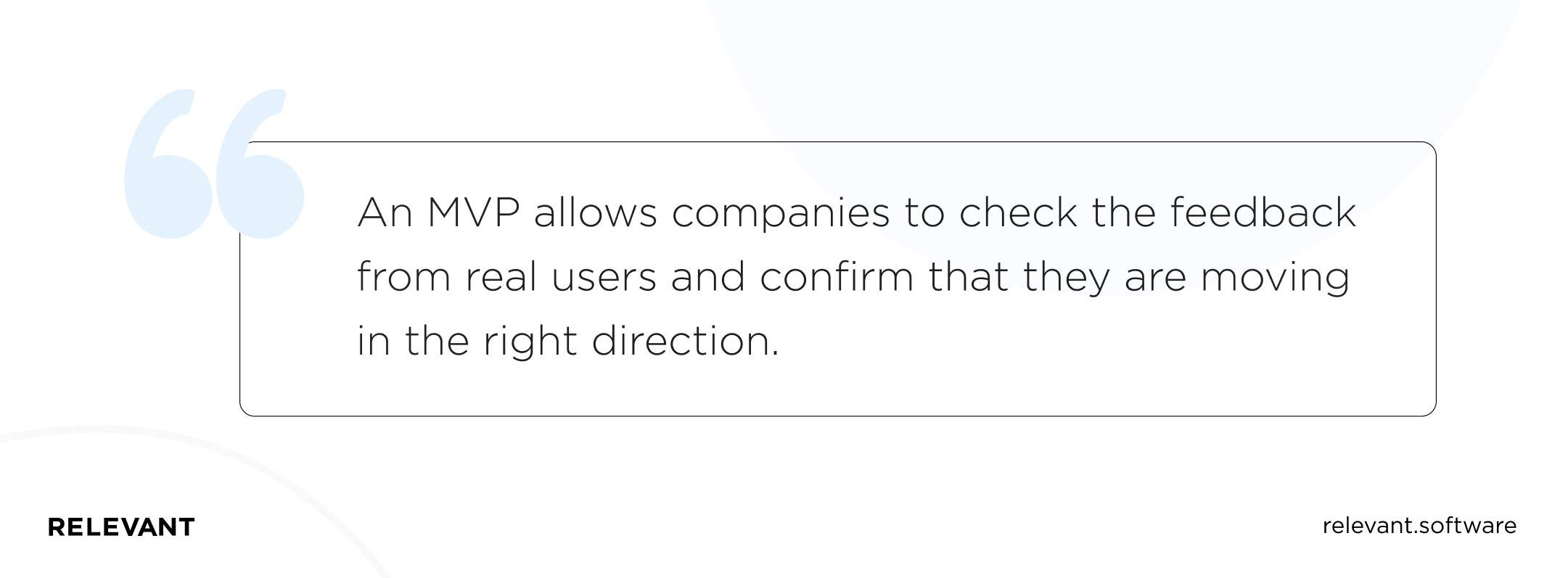
An MVP is an early version of your future billing software with barebone functionality. It allows companies to check the feedback from real users and confirm that they are moving in the right direction. The analytical data you collect at this stage will enable you to eliminate unnecessary features and make more informed decisions before scaling up.
Fully-fledged product development
With MVP development services at hand, the process becomes more focused and moves faster. Yet, there are two important factors that your team needs to focus on throughout the development process:
- APIs and integrations. Billing software includes many features that can be either built from scratch or provided by third-party services (bill tracking, basic transactions, chat support, and others). Keep in mind that even if you opt to develop it from scratch, you still need your app to be able to integrate third-parties application programming interfaces (APIs) securely and flawlessly.
- Security. The app should be built with security in mind because it will collect personal and financial information. Making sure that your billing software has all the necessary security features we mentioned earlier isn’t enough. Your development team needs to implement secure application logic, role-based access control, and other fintech app security solutions to keep your data safe.
Software maintenance
The final stage of any development includes maintenance and updates when software is being refined and enhanced according to the user feedback on its performance. Billing software is a dynamically changing product, and at this stage, you can upgrade the functionality, add new features, scale up, and more. So make sure that your software is being constantly tested and regularly updated.
Developing billing software is a complex task and includes many stages throughout the process. Besides, the project won’t end after the development is finished, as is the case of Svenn – a Norwegian company that serves small construction businesses in over 45 countries.
Billing software features developed by Relevant
Our story with Svenn began in 2015 when the company decided to roll out mature SaaS construction project management software. Fast-forward several years, and now Svenn is a platform of choice for over 10,000 daily users.
The platform is designed to simplify most daily tasks project managers deal with, from time tracking to billing processing.
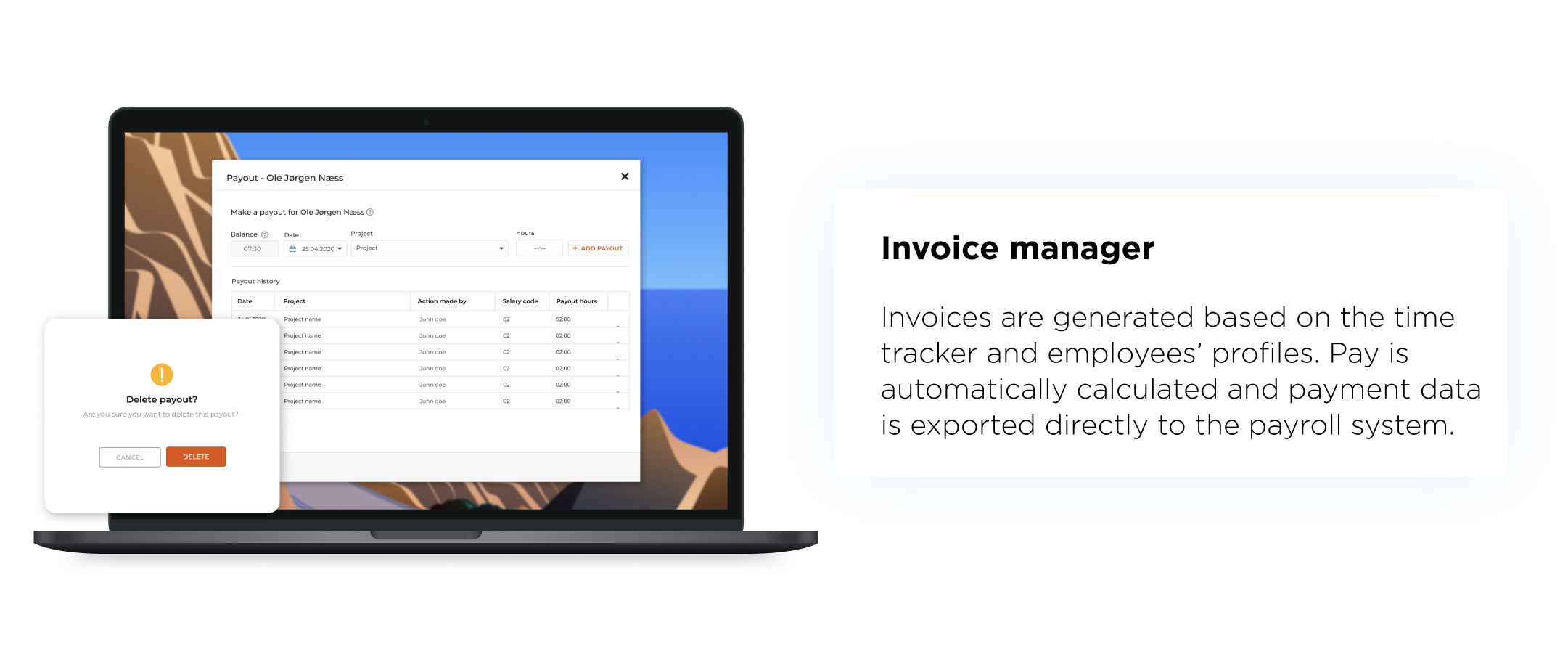
As we specialize in web and mobile app development services, we embedded these features into Svenn’s web platform and app for iOS and Android.
Tech stack
When building a construction management system for Svenn, we created a modular architecture to make the end solution flexible. With that, we stuck to a nimble tech stack:
- Cloud services: AWS
- Programming languages: PHP, Java, Swift
- Frameworks: Yii 2.0, Angular
- Databases: MySQL
- Runtime environment: Node.js
We also used other technologies and tools like Cron, Elasticsearch, and Kibana to keep Svenn well-presented at all levels.
Challenges
When creating a Svenn platform, we faced several challenges associated with:
- Customization
- Data accuracy
- Permissions
- Integrations
But these challenges galvanized us into finding the right solutions to set Svenn up for success. We customized the platform’s reporting tool for granular reports without overhauling the entire system and skyrocketing development costs.
Integrations are challenging in their own right, regardless of the software type (dive into the process for ERP solutions). For Svenn, we surmounted the difficulties with data silos and inefficiencies while integrating a flexible billing system into the platform. This allowed Svenn to offer users additional payment-related functionality and scale without roadblocks.
We assume that by now, you’ve already started to estimate the costs of the project. Let’s do it together.
How much does it cost to create custom invoicing software?
The cost of custom billing software development will vary depending on the number of features you need, the tech stack, the time frame, and the size of your team. To better understand how much it can cost, let’s analyze the team structure.
For most projects, the team will include specialists in the following categories:
- Business analysis
- UX/UI design
- Development (specialists will vary depending on the tech stack you’ve chosen for the project)
- Testing and launch
- Post-launch support (maintenance)
- Platform management
Depending on your project requirements and size, each category will include several experts. For example, the basic project team will consist of one business analyst, one designer, two back-end developers, one front-end developer, and two quality control engineers.
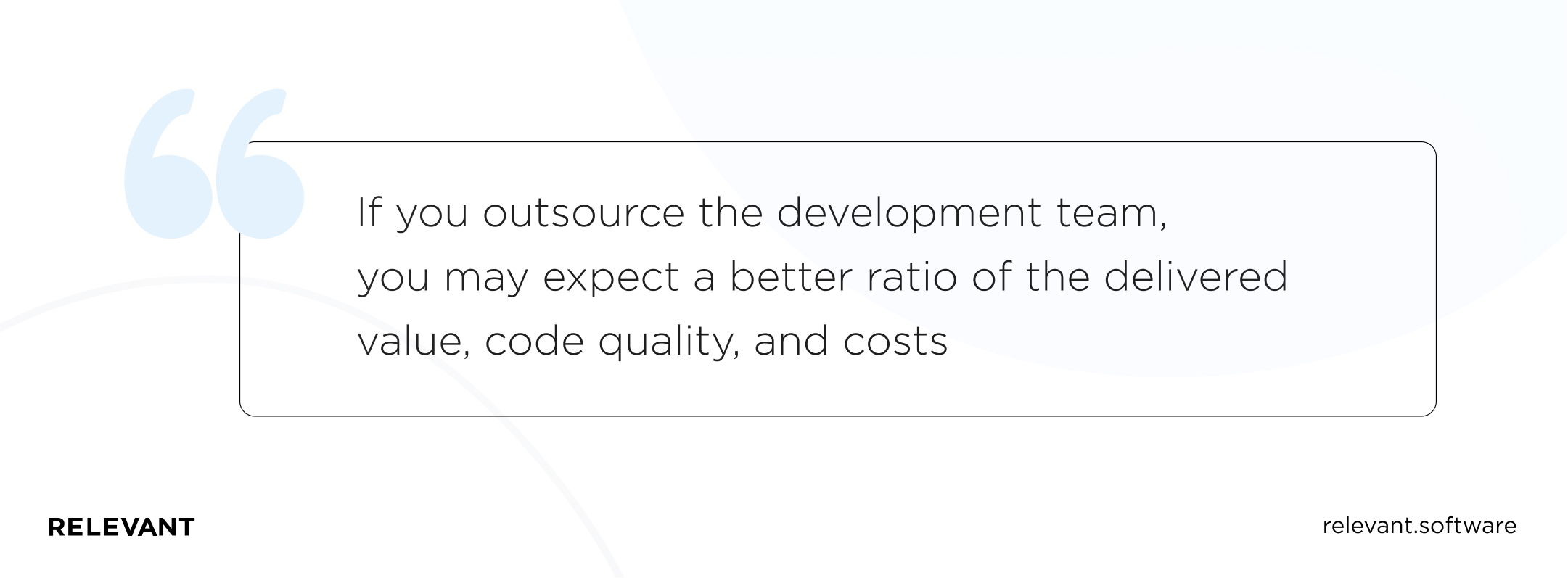
If you outsource the development team, you may expect a better ratio of the delivered value, code quality, and costs. How? Choose Ukraine as your outsourcing destination. It’s one of the best countries to outsource software development worldwide.
An hourly rate for developers in the USA can be up to $150. Meanwhile, a senior engineer in Ukraine will cost you $40-$70 per hour, which is two or three times less. The same is true for other specialists. Ukrainian UX/UI designers charge $35-$56 per hour, while quality assurance specialists will cost you $25-$63 per hour, depending on their experience and skills.
Summary
With the growing trend for a real-time economy and government enforcement of e-invoicing, billing software should be an essential part of your finance department. If you’re about to build one in your company, have a look at this checklist to make sure that nothing is missing.
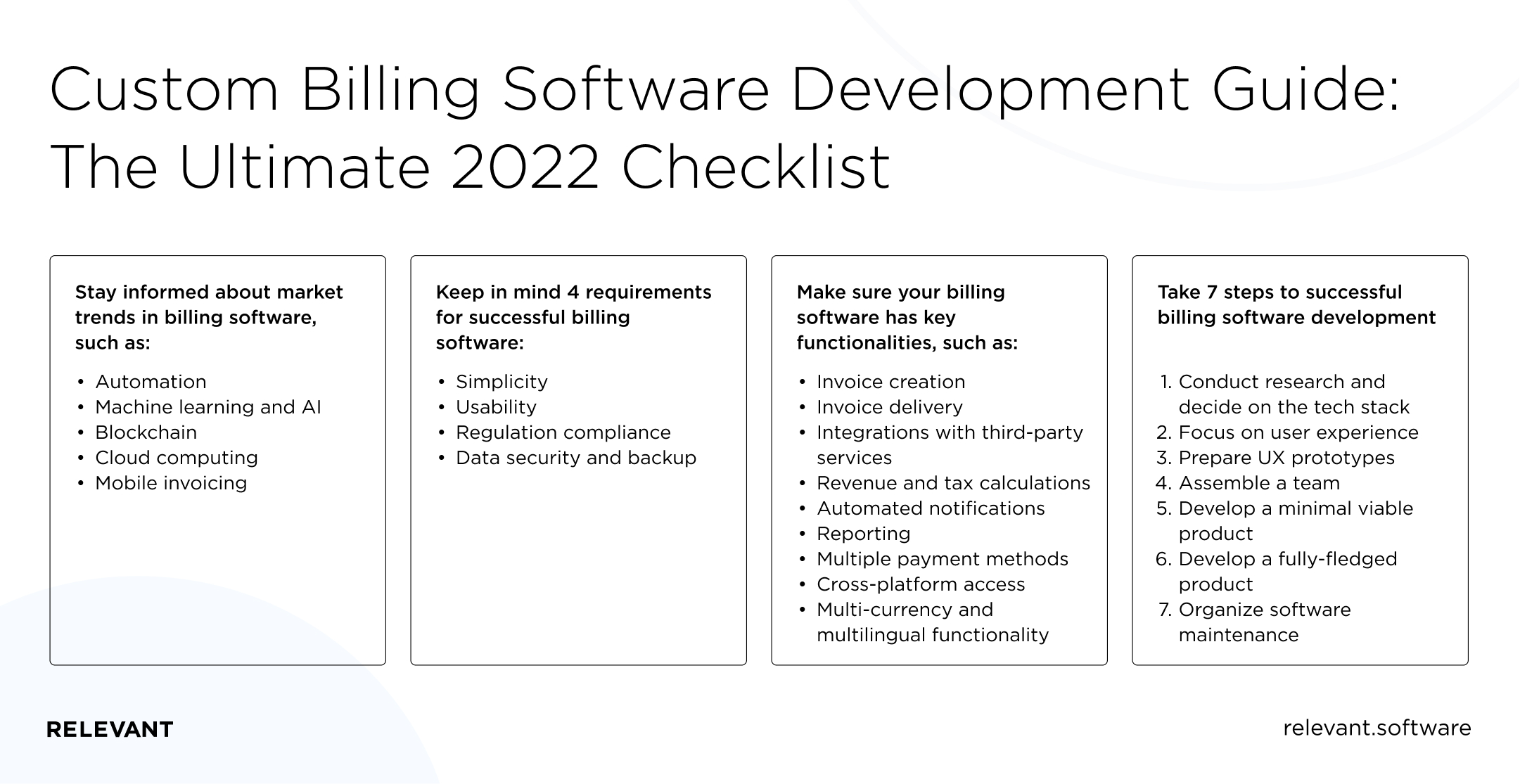
Joining forces with a reliable outsourcing development provider like Relevant can give your project a jump start. With eight years of hands-on experience in fintech full-cycle development and over 200 completed projects, Relevant knows how to design a billing system that your team will love. Contact us to discuss your billing software development project!
Our core services:
Do you want a price estimate for your project?
Do you know that we helped 200+ companies build web/mobile apps and scale dev teams?
Let's talk about your engineering needs.
Write to us











